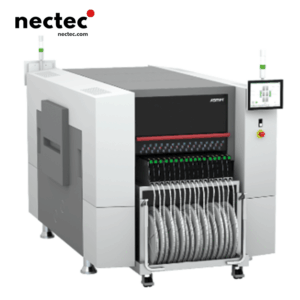As the electronics manufacturing industry continues to evolve, the demand for efficient, reliable, and innovative surface-mount technology (SMT) pick and place machines has surged. These machines are integral in the assembly of printed circuit boards (PCBs) where precise placement of components is crucial for the proper functioning of electronic devices. In this article, we’ll explore the latest advancements, trends, and considerations in the world of SMT pick and place machines in 2023.
Zrozumienie technologii Pick and Place SMT
SMT pick and place machines automate the placement of SMT components onto PCBs with high accuracy and speed. These machines utilize vision systems, sophisticated software, and precise mechanical movements to ensure that components are positioned perfectly, reducing labor costs and increasing production efficiency.
Current Innovations in Pick and Place Machines
The landscape of SMT pick and place technology is being shaped by various innovations aimed at enhancing performance, accuracy, and flexibility. Here are some of the key trends and breakthroughs:
1. Increased Automation and Integration
As technology advances, there is a strong push for greater automation in SMT assembly processes. Modern pick and place machines are increasingly integrated with factory management systems, allowing real-time data collection and monitoring. This integration not only helps in maintaining optimal production rates but also provides valuable insights into process efficiencies.
2. Ulepszone systemy wizyjne
Vision systems play a critical role in the function of pick and place machines. Recent improvements in artificial intelligence (AI) and machine learning have significantly enhanced the capability of these systems. They now offer better component recognition, even under challenging conditions involving low contrast or with small components. This ensures higher placement accuracy and can minimize errors caused by operator fatigue.
3. Flexibility in Machine Configuration
Today’s manufacturers require flexibility to switch between different product lines rapidly. Leading manufacturers now offer modular designs that allow for easy reconfiguration of machines based on the production needs. This adaptability is vital in an environment where demand can fluctuate unpredictably.
Rola Przemysłu 4.0
Industry 4.0, characterized by the interconnectivity of machines via the Internet of Things (IoT), is heavily influencing the operation of SMT pick and place machines. Machines are now capable of communicating with each other, leading to coordinated operations that enhance overall production efficiency. This interconnected environment allows manufacturers to track production metrics and adjust workflows based on real-time data.
Czynniki brane pod uwagę przy wyborze maszyny Pick and Place
With numerous options available, selecting the right SMT pick and place machine can be daunting. Here are some important considerations to take into account:
1. Typy i rozmiary komponentów
Different pick and place machines have varying capabilities regarding the types and sizes of components they can handle. It’s crucial to choose a machine that can accommodate the specific components used in your projects, including tiny resistor packages and larger devices, without compromising on accuracy.
2. Wielkość produkcji
Consider the production volume you expect to achieve. High-volume operations may benefit from more advanced machines with higher speed and efficiency, whereas smaller operations may find that budget-friendly options suffice.
3. Wsparcie posprzedażowe i serwis
A reliable after-sales support system is crucial for minimizing downtime. Ensure your chosen supplier offers extensive warranties, user training, and responsive technical support to handle any issues that arise.
Względy środowiskowe i zrównoważony rozwój
As businesses globally are becoming greener, many SMT pick and place machine manufacturers are focusing on sustainability. Machines that optimize energy consumption and reduce waste are increasingly sought after. Furthermore, techniques such as lead-free soldering and energy-efficient operations are essential trends in the manufacturing world moving forward.
The Global Market and Competitive Landscape
The demand for SMT pick and place machines is growing globally with increasing electronics production in Asia-Pacific, Europe, and North America. Countries like China, Taiwan, and Japan are leading the way due to their strong electronic manufacturing ecosystems.
Major players in the SMT machinery industry are continually innovating to maintain their competitive edge. Market participants are investing heavily in research and development to launch new features that align with the latest technologies. This investment is vital for small and medium manufacturers who aspire to remain relevant in an increasingly competitive landscape.
Best Practices for Maintaining Your Pick and Place Machine
Maintenance is key to ensuring that SMT pick and place machines perform at their best. Here are some best practices:
1. Regularne czyszczenie
Ensure that components and feeders are cleaned regularly to prevent dust and debris from causing malfunctions. Schedule routine cleanings to extend the lifespan of the machine and maintain optimal performance.
2. Kalibracja
Calibrate the machine frequently to ensure that it is performing within the specified tolerances. This should be done based on the manufacturer’s guidelines to ensure accuracy in component placement.
3. Szkolenie personelu
Provide comprehensive training for machine operators. Well-trained staff are less likely to make errors that could lead to machine damage or unproductive downtime.
Key Takeaways for Manufacturers
As we move further into 2023, staying abreast of innovations in SMT pick and place machines is vital for manufacturers. Adopting advanced technology, embracing automation, considering environmental impact, and understanding the competitive landscape are all critical components in making informed decisions about machinery investments.
The evolution of SMT technology continues to shape the electronics manufacturing landscape, ensuring that companies have the tools necessary to meet ever-growing consumer demands while maintaining quality and efficiency.







